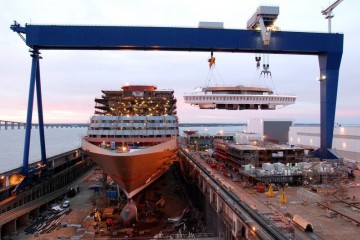Port pricing seems a pretty arcane subject, but is an essential tool for solving the main challenges posed by mega-ships. These challenges are related to costs, peaks and risks. Port pricing provides possibilities to takes these into account. In other words: to internalise externalities. This blogpost will provide some ideas on how this could be done, and under which conditions this could work.
We wrote earlier about mega-ships. These bring three big problems. First, mega-ships generate costs for the transport chain that are larger than the cost savings for shipping lines from the mega-ships. Additional costs for ports typically include dredging, longer and stronger quay walls and other adaptations of infrastructure. Additional costs for terminals are related to the need for higher and larger cranes, more cranes and bigger yards.
The second problem is the peaks and troughs that mega-ships create and that will require more flexibility in the whole supply chain. Peaks in labour, requiring more gangs and overtime; peaks regarding equipment that is intensively used during the peak but under-utilised most of the time.
The third problem is related to risks: supply chain risks for shippers, higher risks for shipping lines in case of accidents, and more elevated risks for ports and terminals to lose large chunks of cargo due to shifts in port choice by mega-alliances, directly related to mega-ships.
There are three possible ways to resolve these problems: market, regulation and internalisation of externalities.
The shipping sector traditionally has a strong belief in the market (an adherence to market principles that is in fact fairly selective as I will state in one of my next blogposts). Many think that the market will take care of reaching the optimal ship size – the disappearance of super-tankers is often stated as proof. However, going even bigger – say to 24,000 TEU ships – could still bring some cost savings – around 5%; so it is likely that lines will pursue these as soon as strong cargo growth is back.
A second approach would be regulating ship size. The size of trucks, trains and planes is regulated, why not ships? The instrument might be blunt, and certainly difficult to realise, but it is not impossible.
The third solution seems the most feasible: internalisation of externalities; user pays; and this is where port pricing comes into play.
The current port pricing system is favourable to mega-ships. Most ports tariffs are – on paper – proportional to the gross tonnage of ships; in practice, many ports use volume discounts favourable to big clients with big ships. Some ports use a maximum tariff that kicks in around ship capacity of around 5,000 TEU, which represents a blatant form of cross-subsidisation. Ports make the largest costs for the largest ships, but these often pay less (in relative terms) than smaller ships. Terminal handling charges often consist of a price per move, with a higher price for full containers and import/export containers; lower prices for empties and transshipment. Terminals, like ports, make more costs for handling mega-ships but do not charge more to the mega-ships they handle.
Which changes of port prices would be needed? In general more application of the user-pays principle: ships that generate more costs should pay more. In ports that could mean that there is a harbour maintenance fund based on costs incurred: the largest ships need more dredging so also need to pay for it. It could also imply charging for congestion, both at the quay side and at the terminal gate. For terminals application of the user pays-principle could mean more ship size-related charges, bonus/malus related to productivity, discounts for unpopular berth windows, charges for delays of ships.
Which institutional changes would be needed to make this happen? It would require some coordination between ports that are competing with each other, to avoid that public subsidies are used to reduce port tariffs and subsidise mega-ships. This requires more financial transparency of ports – and port authorities that take seriously their public role; all too often ports have become almost exclusively focused on making profits. In some areas of the world, supra-national coordination might be needed to achieve more alignment between ports.
In the terminal business one could expect various mechanisms to mitigate the risks related to mega-carriers and mega-alliances. Dedicated terminals, joint ventures with shipping lines and longer term contracts could all help to create more long term loyalty by shipping lines vis-à-vis terminals. Direct links between shippers and terminals would be a way to reduce the dependence on decisions of shipping lines.
Finally, stopping cross-subsidies to mega-ships could also be in the interest of carriers, as it would mean the end of ship overcapacity induced by continuous new rounds of ever bigger ships. If carriers start to pay the real costs of mega-ships, upsizing will soon come to end and with it the frantic orders by carriers that do not want to stay behind.
1 Comments
Comments are closed.




In theory this is an interesting proposition. However to actually do this may require more than simply getting the various key decision makers to sit together. Look at how the alliances of small size vessels like GA, G6 etc are being swallowed by 2M, and now O3. Perhaps an easier way would be for port operators to start the strategic partnership to reduce competition and gaps so that shipping lines will have less room to manouvre for lower rates at the ports. There must be a balanced mechanism between the bargaining power for both parties. Mega ships operators should not have so much leverage for low rates at the ports simply because they could bring the volumes more compared to the other players. At the end of the day the objective is to move boxes at the value for money costs so that the consumers do not have to pay for more than necessary.